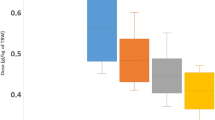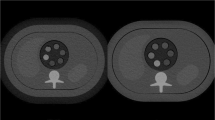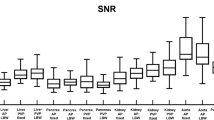Abstract
Purpose
To compare hepatic parenchymal contrast media (CM) enhancement during multi-detector row computed tomography (MDCT) and its correlation with volume pitch-corrected computed tomography dose index CTDIvol) and body weight (BW).
Material and methods
One hundred patients referred for standard three-phase thoraco-abdominal MDCT examination were enrolled. BW was measured in the CT suite. Forty grams of iodine was administered intravenously (iodixanol 320 mg I/ml at 5 ml/s or iomeprol 400 mg I/ml at 4 ml/s) followed by a 50-ml saline flush. CTDIvol presented by the CT equipment during the parenchymal examination was recorded. The CM enhancement of the liver was defined as the attenuation HU of the liver parenchyma during the hepatic parenchymal phase minus the attenuation in the native phase.
Results
Liver parenchymal enhancement was negatively correlated to both CTDIvol (r = −0.60) and BW (r = −0.64), but the difference in correlation between those two was not significant.
Conclusion
CTDIvol may replace BW when adjusting CM doses to body size. This makes it potentially feasible to automatically individualize CM dosage by CT.
Key points
• CTDI vol is related to liver CM enhancement in the parenchymal phase.
• CTDI vol provides comparable information to body weight (BW).
• CTDI vol may be used when automatically adjusting CM dose for patient size.



Similar content being viewed by others
References
Stacul F, Molen J, Reimer P et al (2011) Contrast induced nephropathy: updated ESUR contrast media safety committee guidelines. Euro Radiol 21:2527–2541
Kormano M, Partanen K, Soimakallio S, Kivimaeki T (1983) Dynamic contrast enhancement of the upper abdomen: effect of contrast medium and body weight. Invest Radiol 18:364–367
Kormano M, Dean P (1976) Extravascular contrast material: the major component of contrast enhancement. Radiology 121:379–382
Yasuyuki Y, Yasuyuki K, Mutsumasa T et al (2000) Abdominal helical CT: evaluation of optimal doses of intravenous contrast material–a prospective randomized study. Radiology 216:718–723
Bae KT (2010) Intravenous contrast medium administration and scan timing at CT: considerations and approaches. Radiology 256:32–61
Ho L, Nelson R, Delong D (2007) Determining contrast medium dose and rate on basis of lean body weight: does this strategy improve patient-to-patient uniformity of hepatic enhancement during multi-detector row CT? Radiology 243:431–437
Kondo H, Kanematsu, Goshima S et al (2010) Body size indexes for optimizing iodine dose for aortic and hepatic enhancement at multidetector CT: comparison of total body weight, lean body weight, and blood volume. Radiology 254:163–169
Yanaga Y, Awai K, Nakayama Y et al (2007) Pancreas: patient body weight tailored contrast material injection protocol versus fixed dose protocol at dynamic CT. Radiology 245:2
Ichikawa T, Erturk S, Araki T (2006) Multiphasic contrast-enhanced multidetector-row CT of liver: contrast-enhancement theory and practical scan protocol with a combination of fixed injection duration and patients body-weight-tailored dose of contrast material. Eur J Radiol 58:165–176
Bae K, Seeck B, Hildebolt C et al (2008) Contrast enhancement in cardiovascular MDCT: effect of body weight, height, body surface area, body mass index, and obesity. AJR 190:777–784
Mahadevappa M (2009) MDCT physics: the basics: technology, image quality and radiation dose. Lippincott Williams & Wilkins, Philadelphia
McCollough C, Bruesewitz M, Kofler J (2006) CT dose reduction and dose management tools: overview of available options. Radiographics 26:503–512
Li X, Samei E, Williams C et al (2012) Effects of protocol and obesity on dose conversion factors in adult body CT. Med Phys 39:11
Khatonabadi M, Kim H, Lu P, McMillan K, Cagnon C (2013) The feasibility of a regional CTDIvol to estimate organ dose from tube current modulated CT exams. Med Phys 40:5
Svensson A, Nouhad J, Cederlund K, Aspelin P, Nyman U, Björk J, Torkel BB (2012) Hepatic contrast medium enhancement at computed tomography and its correlation with various body size measures. Acta Radiol 53:601–610
Acknowledgements
The scientific guarantor of this publication is Anders Svensson, Department of Clinical Science, Intervention and Technology at Karolinska Institutet, Division of Medical Imaging and Technology, Stockholm, Sweden and Department of Radiology, Karolinska University Hospital in Huddinge, SE-14186 Stockholm, Sweden. The authors of this manuscript declare no relationships with any companies whose products or services may be related to the subject matter of the article. Jonas Björk (FoU-centrum Skåne Skånes Universitetssjukhus i Lund, Sweden) kindly provided statistical advice for this manuscript. One of the authors has significant statistical expertise. No complex statistical methods were necessary for this paper. Institutional review board approval was obtained. Written informed consent was obtained from all subjects (patients) in this study. Methodology: retrospective, performed at one institution.
Author information
Authors and Affiliations
Corresponding author
Rights and permissions
About this article
Cite this article
Svensson, A., Björk, J., Cederlund, K. et al. Automatic individualized contrast medium dosage during hepatic computed tomography by using computed tomography dose index volume (CTDIvol). Eur Radiol 24, 1959–1963 (2014). https://doi.org/10.1007/s00330-014-3220-z
Received:
Revised:
Accepted:
Published:
Issue Date:
DOI: https://doi.org/10.1007/s00330-014-3220-z




